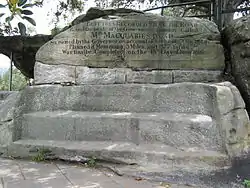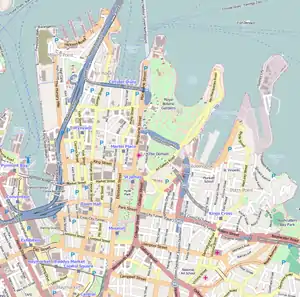Mrs Macquarie's Chair
Mrs Macquarie's Chair (also known as Lady Macquarie's Chair[1]) is an exposed sandstone rock cut into the shape of a bench, on a peninsula in Sydney Harbour. It was hand carved by convicts in 1810, for Elizabeth Macquarie, the wife of Major-General Lachlan Macquarie, Governor of New South Wales. The peninsula itself was known to the Gadigal as Yurong Point,[2][3] and is now widely known as Mrs Macquarie's Point, and is part of The Domain, near the Royal Botanic Gardens.[4][5]
Mrs Macquarie's Chair
Lady Macquarie's Chair | |
|---|---|
 Mrs Macquarie's Chair, near the Royal Botanic Gardens, Sydney | |
 Mrs Macquarie's Chair | |
| Coordinates: 33°51′34.08″S 151°13′19.93″E | |
| Location | The Domain, near the Royal Botanic Gardens, Sydney, New South Wales, Australia |
| Part of | The Domain |
| Offshore water bodies | Port Jackson |
| Geology | Sydney sandstone |
Description
Mrs Macquarie was the wife of Major-General Lachlan Macquarie, Governor of New South Wales from 1810 to 1821. Folklore has it that she used to sit on the rock and watch for ships from Great Britain sailing into the harbour. She was known to visit the area and sit enjoying the panoramic views of the harbour.
Above the chair is a stone inscription referring to Mrs Macquarie's Road. That road was built between 1813 and 1818, and ran from the original Government House (now the Museum of Sydney) to Mrs Macquarie's Point.[6] It was built on the instruction of Governor Macquarie for the benefit of his wife.[7] There is no remaining evidence of the original road, other than a culvert over which the road ran—the Macquarie Culvert.[6]
The stone inscription reads as follows.
- Be it thus Recorded that the Road
- Round the inside of the Government Domain Called
- Mrs. Macquarie's road
- So named by the Governor on account of her having Originally
- Planned it Measuring 3 Miles, and 377 Yards
- Was finally Completed on the 13th Day ofJune 1816
The peninsula sits between the Garden Island peninsula to the east and Bennelong Point (where the Sydney Opera House resides) to the west. The chair itself faces north-east towards Fort Denison and the Tasman Sea. The area around it on Mrs Macquarie's Point is a popular lookout position for the view to the north-west of the Sydney Opera House and Sydney Harbour Bridge.
References
- "Mrs Macquarie's Chair". Travel Promote. Retrieved 4 March 2018.
- Irish, Paul; Goward, Tamika. "Yurong Cave and Yurong Midden". Barani: Sydney's Aboriginal History. Retrieved 3 July 2019.
- Royal Anthropological Society of Australasia. (1898), Science of man and journal of the Royal Anthropological Society of Australasia, G. Watson, retrieved 3 July 2019
- "Fountains, sculptures and memorials in the Royal Botanic Garden and the Domain". The Royal Botanic Garden & Domain Trust. Archived from the original on 6 December 2013. Retrieved 8 December 2013.
- "Domain Walk". The Royal Botanic Garden & Domain Trust. Archived from the original on 6 December 2013. Retrieved 8 December 2013.
- Higginbotham, Edward (1992). "Historical and Archaeological Assessment of the Brick Culvert, Lady Macquarie's Road, Royal Botanic Gardens, Sydney, N.S.W." (PDF). doi:10.4227/11/50495ba10e3e0.
{{cite journal}}: Cite journal requires|journal=(help) - Our Convict Heritage (Sign near the culvert in the Royal Botanic Gardens). 1 December 2013.